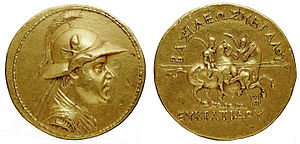Alexandria on the Oxus

Gold coin of Eucratides I (171–145 BC), one of the Hellenistic rulers of ancient Ai-Khanoum. This is the largest gold coin minted in Antiquity.
|
|
| Alternate name | Ay Khanum |
|---|---|
| Location | Takhar Province, Afghanistan |
| Region | Bactria |
| Coordinates | 37°10′10″N 69°23′30″E / 37.16944°N 69.39167°ECoordinates: 37°10′10″N 69°23′30″E / 37.16944°N 69.39167°E |
| Type | Settlement |
| History | |
| Founded | circa 280 BC, 3rd century BC |
| Abandoned | Possibly between 145 and 120 BC |
| Periods | Hellenistic |
| Cultures | Greek |
| Site notes | |
| Excavation dates | Between 1964 and 1978 |
| Archaeologists | Paul Bernard |
| Condition | Ruined |
Ai-Khanoum or Ay Khanum (lit. “Lady Moon” in Uzbek, possibly the historical Alexandria on the Oxus, also possibly later named اروکرتیه or Eucratidia) was one of the primary cities of the Greco-Bactrian kingdom. Previous scholars have argued that Ai Khanoum was founded in the late 4th century BC, following the conquests of Alexander the Great. Recent analysis now strongly suggests that the city was founded c. 280 BC by the Seleucid king Antiochus I. The city is located in Takhar Province, northern Afghanistan, at the confluence of the Oxus river (today's Amu Darya) and the Kokcha river, and at the doorstep of the Indian subcontinent. Ai-Khanoum was one of the focal points of Hellenism in the East for nearly two centuries, until its annihilation by nomadic invaders around 145 BC about the time of the death of Eucratides.
The site was excavated through archaeological searches by a French DAFA mission under Paul Bernard between 1964 and 1978, as well as Russian scientists. The searches had to be abandoned with the onset of the Soviet war in Afghanistan, during which the site was looted and used as a battleground, leaving very little of the original material.
The choice of this site for the foundation of a city was probably guided by several factors. The region, irrigated by the Oxus, had a rich agricultural potential. Mineral resources were abundant in the back country towards the Hindu Kush, especially the famous so-called "rubies" (actually, spinel) from Badakshan, and gold. Its location at the junction between Bactrian territory and nomad territories to the north, ultimately allowed access to commerce with the Chinese empire. Lastly, Ai-Khanoum was located at the very doorstep of Ancient India, allowing it interact directly with the Indian subcontinent.
...
Wikipedia

